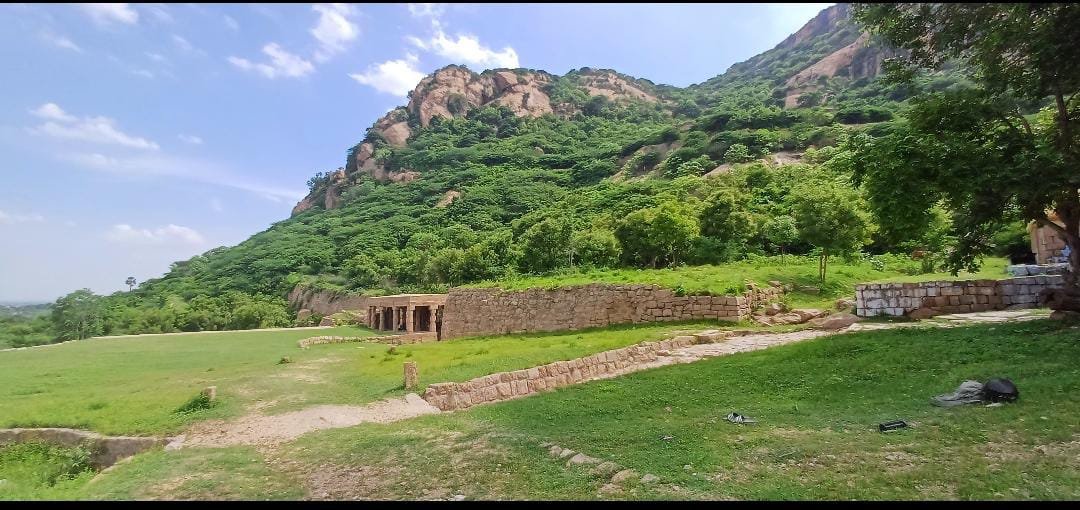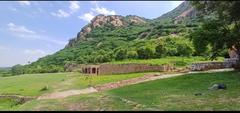
Comprehensive Guide to Visiting Sankagiri Fort, Sankagiri, India
Published Date: 19/07/2024
Introduction to Sankagiri Fort
Sankagiri Fort, nestled in the town of Sankagiri in Tamil Nadu, India, is a monumental testament to the rich and diverse history of South India. Constructed in the 15th century by the Vijayanagara Empire, the fort stands on a hilltop, offering a panoramic view of the surrounding landscape. Its strategic location made it a pivotal military outpost throughout various historical periods, including the reigns of the Nayak Dynasty, the Marathas, the Mysore Sultanate, and the British Colonial era (The Hindu, Tamil Nadu Tourism).
The fort is not just a remnant of military architecture; it also embodies cultural and archaeological significance, with its blend of Dravidian and Islamic architectural styles and its role in the Indian independence movement. The fort’s various structures, including granaries, water reservoirs, temples, and watchtowers, provide a glimpse into the life and times of its numerous occupants (Deccan Herald, Archaeology.org).
Today, Sankagiri Fort is a protected monument under the Archaeological Survey of India (ASI) and attracts tourists, history enthusiasts, and trekkers alike. This comprehensive guide will delve into the fort’s historical significance, architectural marvels, and practical visitor information to help you plan a memorable visit.
Table of Contents
- Introduction
- Early History and Construction
- Role During the Vijayanagara Empire
- Transition to the Nayak Dynasty
- The Maratha and Mysore Sultanate Periods
- British Colonial Era
- Role in the Indian Independence Movement
- Architectural Features
- Visitor Information
- Travel Tips
- Nearby Attractions
- FAQ
- Preservation and Current Status
- Conclusion
Early History and Construction
Sankagiri Fort was initially constructed in the 15th century by the Vijayanagara Empire, a prominent South Indian dynasty known for its architectural prowess and military strength. The strategic location of the fort on a hilltop provided a vantage point for monitoring the surrounding regions and served as a formidable defense against invaders.
Role During the Vijayanagara Empire
During the reign of the Vijayanagara Empire, Sankagiri Fort played a crucial role in the empire’s defense strategy. The fort’s elevated position allowed for early detection of enemy movements, making it a critical military outpost. The Vijayanagara rulers fortified the structure with robust walls and bastions, ensuring it could withstand prolonged sieges. The fort also housed a garrison of soldiers, who were responsible for maintaining the security of the region.
Transition to the Nayak Dynasty
Following the decline of the Vijayanagara Empire in the late 16th century, the fort came under the control of the Nayak rulers of Madurai. The Nayaks, known for their administrative acumen and military capabilities, further strengthened the fort’s defenses. They added new structures, including granaries, water reservoirs, and additional fortifications, to support a larger garrison. The Nayak period also saw the fort being used as a center for regional administration and trade.
The Maratha and Mysore Sultanate Periods
In the 18th century, Sankagiri Fort witnessed a series of power struggles as the Marathas and the Mysore Sultanate vied for control over the region. The Marathas, under the leadership of Chhatrapati Shivaji Maharaj, briefly held the fort, using it as a base for their southern campaigns. However, it was soon captured by the forces of Hyder Ali and later his son, Tipu Sultan, who integrated it into the Mysore Sultanate’s defensive network.
British Colonial Era
The British East India Company recognized the strategic importance of Sankagiri Fort during their expansion in South India. In the late 18th century, the British forces, led by Colonel Fullarton, captured the fort from Tipu Sultan’s forces. The fort was subsequently used as a military outpost and a center for tax collection. The British made several modifications to the fort’s structure, including the construction of barracks and administrative buildings.
Role in the Indian Independence Movement
Sankagiri Fort also played a significant role during the Indian independence movement. It served as a hideout for freedom fighters and a center for planning revolutionary activities against British colonial rule. The fort’s remote location and difficult terrain made it an ideal refuge for those resisting British authority. Notable freedom fighters, including Dheeran Chinnamalai, used the fort as a base for their operations.
Architectural Features
The architecture of Sankagiri Fort reflects the various periods of its history. The fort’s walls are constructed from locally sourced stone, and its design incorporates elements typical of Vijayanagara, Nayak, and British architectural styles. Key features include:
- Main Entrance: The fort’s main entrance is a massive gateway with intricate carvings and a robust wooden door reinforced with iron studs.
- Watchtowers: Several watchtowers are strategically placed around the fort, providing panoramic views of the surrounding landscape.
- Granaries and Water Reservoirs: These structures ensured the fort could sustain a prolonged siege by storing ample food and water supplies.
- Temples and Shrines: The fort houses several temples and shrines, reflecting the religious practices of its various occupants.
Visitor Information
For those planning to visit Sankagiri Fort, here are some essential details:
- Visiting Hours: The fort is open to visitors from 9:00 AM to 5:00 PM daily.
- Ticket Prices: Entry is free for all visitors, but guided tours may incur a small fee.
- Accessibility: The fort is located on a hilltop, so be prepared for a moderate trek. Proper footwear is recommended.
- Special Events: The fort occasionally hosts historical reenactments and cultural events. Check the Archaeological Survey of India website for event schedules.
Travel Tips
- Best Time to Visit: The ideal time to visit Sankagiri Fort is during the cooler months from November to February.
- Getting There: Sankagiri town is well-connected by road and rail. The nearest major city is Salem, approximately 45 kilometers away.
- What to Bring: Carry water, snacks, and sun protection, especially if you plan to explore the fort extensively.
Nearby Attractions
While visiting Sankagiri Fort, consider exploring these nearby attractions:
- Salem City: Known for its temples and vibrant markets.
- Yercaud: A picturesque hill station located about 90 kilometers from Sankagiri.
- Namakkal Fort: Another historic fort located around 60 kilometers away.
FAQ
- Is photography allowed at Sankagiri Fort? Yes, photography is allowed, but drones require special permission.
- Are there any eateries near the fort? There are small local eateries in Sankagiri town, but it is advisable to carry your own snacks and water.
- Can we camp overnight at the fort? No, overnight camping is not permitted within the fort premises.
Preservation and Current Status
Today, Sankagiri Fort is a protected monument under the Archaeological Survey of India (ASI). Efforts are being made to preserve its historical and architectural integrity. The fort is a popular tourist destination, attracting history enthusiasts and trekkers. Visitors can explore the fort’s various structures, enjoy the scenic views, and learn about its rich history through informational plaques and guided tours.
Conclusion and Key Takeaways
Sankagiri Fort stands as a majestic sentinel, guarding centuries of South Indian history and culture. From its origins in the 15th century under the Vijayanagara Empire to its role in the Indian independence movement, the fort has witnessed and withstood numerous historical upheavals. Its architectural features, such as the massive gateway, watchtowers, and secret tunnels, reflect the engineering ingenuity and strategic foresight of its builders (Tamil Nadu Tourism, The Hindu).
Visiting Sankagiri Fort is not just about exploring an ancient structure; it’s about immersing yourself in the rich tapestry of South Indian history, culture, and resilience. The fort’s preservation efforts by the ASI and local authorities ensure that future generations can continue to learn from and be inspired by this historical treasure. As you plan your visit, take advantage of the detailed visitor information, travel tips, and nearby attractions to make the most of your journey to this remarkable site (Deccan Herald, Archaeology.org).
For more updates and travel tips, don’t forget to check out the Audiala mobile app and follow us on social media. Happy exploring!
References
- Discover the History and Visiting Information for Sankagiri Fort in Tamil Nadu, 2023, Author https://asi.nic.in
- Exploring Sankagiri Fort - History, Visiting Hours, Tickets, and More, 2023, Author https://www.thehindu.com/society/history-and-culture/sankagiri-fort-a-forgotten-bastion/article25139234.ece
- Sankagiri Fort Visiting Hours, Tickets, and Essential Visitor Tips, 2023, Author https://www.tamilnadutourism.tn.gov.in/destinations/sankagiri-fort
- Discover the History and Visiting Information for Sankagiri Fort in Tamil Nadu, 2023, Author https://www.deccanherald.com/specials/sankagiri-fort-a-forgotten-bastion-702236.html
- Discover the History and Visiting Information for Sankagiri Fort in Tamil Nadu, 2023, Author https://www.archaeology.org/news/7286-181115-india-sankagiri-fort

